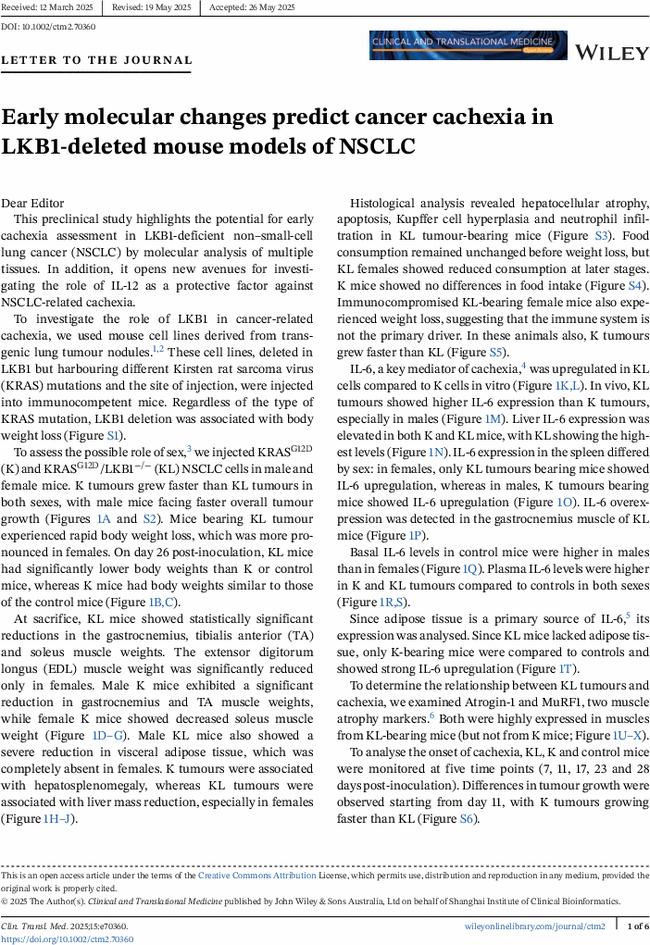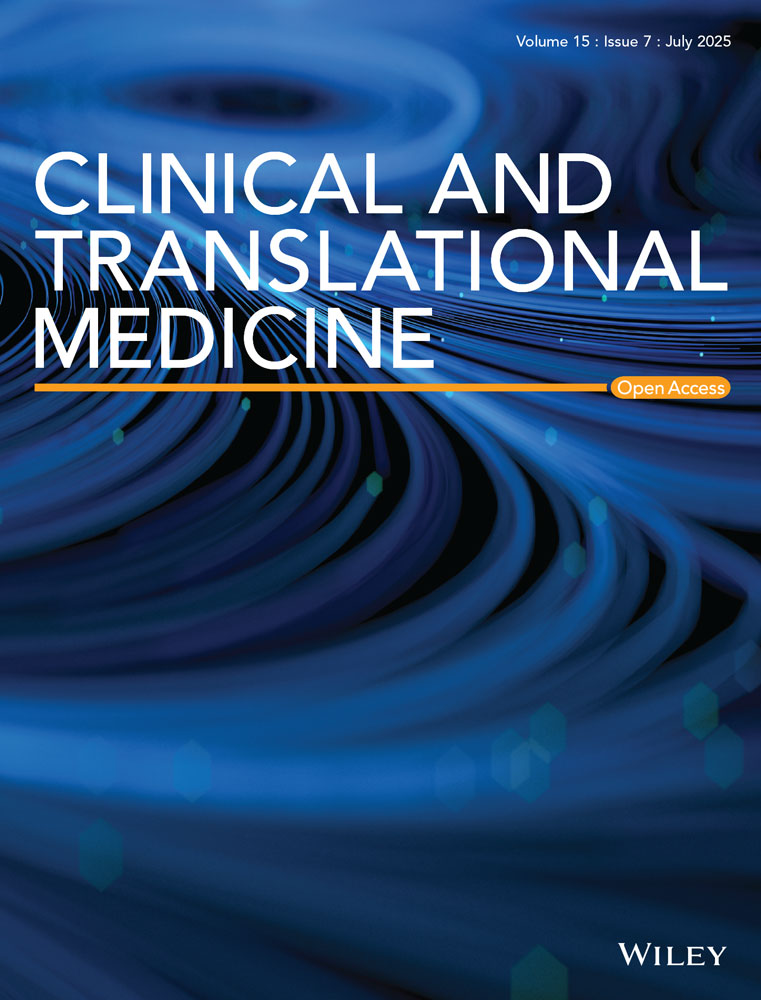Early molecular changes predict cancer cachexia in LKB1-deleted mouse models of NSCLC
Gloriana Ndembe
Laboratory of Molecular Pharmacology, Experimental Oncology Department, Istituto Di Ricerche Farmacologiche Mario Negri IRCCS, Milan, Italy
Search for more papers by this authorAndrea David Re Cecconi
Laboratory of Muscle Pathophysiology, Neuroscience Department, Istituto Di Ricerche Farmacologiche Mario Negri IRCCS, Milan, Italy
Search for more papers by this authorFederica Palo
Laboratory of Muscle Pathophysiology, Neuroscience Department, Istituto Di Ricerche Farmacologiche Mario Negri IRCCS, Milan, Italy
Search for more papers by this authorDorina Belotti
Laboratory of Tumor Microenvironment, Experimental Oncology Department, Istituto Di Ricerche Farmacologiche Mario Negri IRCCS, Milan, Italy
Search for more papers by this authorLaura Sala
Department of Veterinary Medicine and Animal Sciences, University of Milan, Lodi, Italy
Mouse & Animal Pathology Lab, Fondazione UniMi, Milan, Italy
Search for more papers by this authorSelena Foroni
Laboratory of Molecular Pharmacology, Experimental Oncology Department, Istituto Di Ricerche Farmacologiche Mario Negri IRCCS, Milan, Italy
Search for more papers by this authorEugenio Scanziani
Department of Veterinary Medicine and Animal Sciences, University of Milan, Lodi, Italy
Mouse & Animal Pathology Lab, Fondazione UniMi, Milan, Italy
Search for more papers by this authorRosanna Piccirillo
Laboratory of Muscle Pathophysiology, Neuroscience Department, Istituto Di Ricerche Farmacologiche Mario Negri IRCCS, Milan, Italy
Search for more papers by this authorCorresponding Author
Massimo Broggini
Laboratory of Molecular Pharmacology, Experimental Oncology Department, Istituto Di Ricerche Farmacologiche Mario Negri IRCCS, Milan, Italy
Correspondence
Massimo Broggini, Laboratory of Molecular Pharmacology, Experimental Oncology Department, Istituto Di Ricerche Farmacologiche Mario Negri IRCCS, Via Mario Negri 2, Milan, Italy.
Email: [email protected]
Search for more papers by this authorMirko Marabese
Laboratory of Molecular Pharmacology, Experimental Oncology Department, Istituto Di Ricerche Farmacologiche Mario Negri IRCCS, Milan, Italy
Search for more papers by this authorGloriana Ndembe
Laboratory of Molecular Pharmacology, Experimental Oncology Department, Istituto Di Ricerche Farmacologiche Mario Negri IRCCS, Milan, Italy
Search for more papers by this authorAndrea David Re Cecconi
Laboratory of Muscle Pathophysiology, Neuroscience Department, Istituto Di Ricerche Farmacologiche Mario Negri IRCCS, Milan, Italy
Search for more papers by this authorFederica Palo
Laboratory of Muscle Pathophysiology, Neuroscience Department, Istituto Di Ricerche Farmacologiche Mario Negri IRCCS, Milan, Italy
Search for more papers by this authorDorina Belotti
Laboratory of Tumor Microenvironment, Experimental Oncology Department, Istituto Di Ricerche Farmacologiche Mario Negri IRCCS, Milan, Italy
Search for more papers by this authorLaura Sala
Department of Veterinary Medicine and Animal Sciences, University of Milan, Lodi, Italy
Mouse & Animal Pathology Lab, Fondazione UniMi, Milan, Italy
Search for more papers by this authorSelena Foroni
Laboratory of Molecular Pharmacology, Experimental Oncology Department, Istituto Di Ricerche Farmacologiche Mario Negri IRCCS, Milan, Italy
Search for more papers by this authorEugenio Scanziani
Department of Veterinary Medicine and Animal Sciences, University of Milan, Lodi, Italy
Mouse & Animal Pathology Lab, Fondazione UniMi, Milan, Italy
Search for more papers by this authorRosanna Piccirillo
Laboratory of Muscle Pathophysiology, Neuroscience Department, Istituto Di Ricerche Farmacologiche Mario Negri IRCCS, Milan, Italy
Search for more papers by this authorCorresponding Author
Massimo Broggini
Laboratory of Molecular Pharmacology, Experimental Oncology Department, Istituto Di Ricerche Farmacologiche Mario Negri IRCCS, Milan, Italy
Correspondence
Massimo Broggini, Laboratory of Molecular Pharmacology, Experimental Oncology Department, Istituto Di Ricerche Farmacologiche Mario Negri IRCCS, Via Mario Negri 2, Milan, Italy.
Email: [email protected]
Search for more papers by this authorMirko Marabese
Laboratory of Molecular Pharmacology, Experimental Oncology Department, Istituto Di Ricerche Farmacologiche Mario Negri IRCCS, Milan, Italy
Search for more papers by this authorGloriana Ndembe and Andrea David Re Cecconi are co-first authors.

Open Research
DATA AVAILABILITY STATEMENT
Data generated or analysed during this study are included in this published article and its supporting information files. All the raw data are available upon request from the corresponding author.
Supporting Information
| Filename | Description |
|---|---|
| ctm270360-sup-0001-SuppMat.docx1.4 MB | Supporting Information |
Please note: The publisher is not responsible for the content or functionality of any supporting information supplied by the authors. Any queries (other than missing content) should be directed to the corresponding author for the article.
REFERENCES
- 1Ndembe G, Intini I, Moro M, et al. Caloric restriction and metformin selectively improved LKB1-mutated NSCLC tumor response to chemo- and chemo-immunotherapy. J Exp Clin Cancer Res. 2024; 43(1): 6. doi:10.1186/s13046-023-02933-5
- 2Caiola E, Iezzi A, Tomanelli M, et al. LKB1 deficiency renders NSCLC cells sensitive to ERK inhibitors. J Thorac Oncol. 2020; 15(3): 360-370. doi:10.1016/j.jtho.2019.10.009
- 3Zhong X, Zimmers TA. Sex differences in cancer cachexia. Curr Osteoporos Rep. 2020; 18(6): 646-654. doi:10.1007/s11914-020-00628-w
- 4Iyengar P, Gandhi AY, Granados J, et al. Tumor loss-of-function mutations in STK11/LKB1 induce cachexia. JCI Insight. 2023; 8(8):e165419. doi:10.1172/jci.insight.165419
- 5Mohamed-Ali V, Goodrick S, Rawesh A, et al. Subcutaneous adipose tissue releases interleukin-6, but not tumor necrosis factor-alpha, in vivo. J Clin Endocrinol Metab. 1997; 82(12): 4196-4200. doi:10.1210/jcem.82.12.4450
- 6Pretto F, Ghilardi C, Moschetta M, et al. Sunitinib prevents cachexia and prolongs survival of mice bearing renal cancer by restraining STAT3 and MuRF-1 activation in muscle. Oncotarget. 2015; 6(5): 3043-3054. doi:10.18632/oncotarget.2812
- 7Ikeda K, Yamada T. UCP1 dependent and independent thermogenesis in brown and beige adipocytes. Front Endocrinol (Lausanne). 2020; 11: 498. doi:10.3389/fendo.2020.00498
- 8Paval DR, Patton R, McDonald J, et al. A systematic review examining the relationship between cytokines and cachexia in incurable cancer. J Cachexia Sarcopenia Muscle. 2022; 13(2): 824-838. doi:10.1002/jcsm.12912




